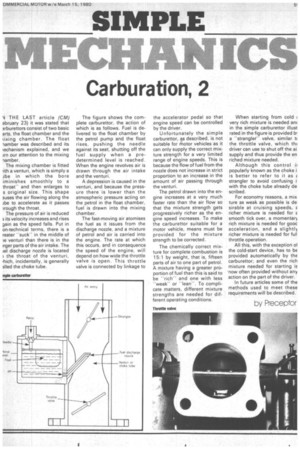Carburation, 2
Page 61

If you've noticed an error in this article please click here to report it so we can fix it.
V THE LAST article (CM) ebruary 23) it was stated that 3rburettors consist of two basic arts, the float chamber and the sixing chamber. The float lamber was described and its iechanism explained, and we irn our attention to the mixing -iamber.
The mixing chamber is fitted ,ith a venturi, which is simply a ibe in which the bore iminishes smoothly to a throat"' and then enlarges to s original size. This shape 3uses the air flowing along the the to accelerate as it passes 1rough the throat.
The pressure of air is reduced 3 its velocity increases and rises gain as the speed falls. Put in on-technical terms, there is a reater "suckin the middle of venturi than there is in the irger parts of the air intake. The Jel discharge nozzle is located 1 the throat of the venturi, ,hich, incidentally, is generally 31Ied the choke tube.
The figure shows the complete carburettor, the action of which is as follows. Fuel is delivered to the float chamber by the petrol pump and the float rises, pushing the needle against its seat, shutting off the fuel supply when a predetermined level is reached When the engine revolves air is drawn through the air intake and the venturi.
A depression is caused in the venturi, and because the pressure there is lower than the atmospheric pressure acting on the petrol in the float chamber, fuel is drawn into the mixing chamber.
The fast-moving air atomises the fuel as it issues from the discharge nozzle, arid a mixture of petrol and air is carried into the engine. The rate at which this occurs, and in consequence the speed of the engine, will depend on how wide the throttle valve is open. This throttle valve is connected by linkage to
the accelerator pedal so that .engine speed can be controlled by the driver.
Unfortunately the simple carburettor, as described, is not suitable for motor vehicles as it can only supply the correct mixture strength for a very limited range of engine speeds. This is because the flow of fuel from the nozzle does not increase in strict proportion to an increase in the amount of air passing through the venturi.
The petrol drawn into the engine increases at a very much faster rate than the air flow so that the mixture strength gets progressively richer as the engine speed increases. To make the carburettor suitable for a motor vehicle, means must be provided for the mixture strength to be corrected.
The chemically correct mixture for complete combustion is 15:1 by weight, that is, fifteen parts of air to one part of petrol. A mixture having a greater proportion of fuel than this is said to be "richand one with less "weakor -lean". To complicate matters, different mixture strengths are needed for different operating conditions. When starting from cold i very rich mixture is needed an( in the simple carburettor illust rated in the figure is provided b, a "stranglervalve, similar tt the throttle valve, which thE driver can use to shut off the ai supply and thus provide the en riched mixture needed.
Although this control iE popularly known as the choke i is better to refer to it as e strangler to avoid confusing r with the choke tube already de scribed.
For economy reasons, a mix ture as weak as possible is de sirable at cruising speeds, richer mixture is needed for E smooth tick over, a momentary rich mixture is needed for gooc acceleration, and a slightly richer mixture is needed for ful throttle operation.
All this, with the exception oi the cold-start device, has to be provided automatically by the carburettor; and even the rich mixture needed for starting is 'now often provided without any action on the part of the driver. In future articles some of the methods used to meet these requirements will be described.
by Preceptor
































































































































